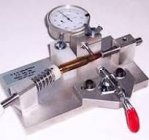Recently, I have been working with a no turn 6BRA. It is an extra, not critical fun gun, something I might put in the hands of a new shooter, that would still be accurate beyond his experience, without wasting a top grade barrel, although this Urban Rifleman barrel seems to be holding its own quite nicely. Anyway, my initial work was with some BT bullets that I managed to mislay (found them today) so I shifted gear to some FB bullets made by a bullet maker who did not stay with it very long. Loading for the BTs I cut a minimal chamfer, and did modify it when I switched to the FB bullets. All went well until I put the finished loads on my concentricity gauge. They were horrible, mostly around .005 where the rifling would touch the bullet. My initial reaction was to blame my seating die, a modified Forster, but then I remembered that a friend had told me that he prefers a heavy chamfer, and I considered that for a minute, before doing a test with a sized case and one of the FB bullets. Problem solved. My thought is that the rather wide flat left by the small chamfer increased the chance for bullets to come out of the chamfer and end up half in and half out of the chamfer as I forced it into the cane neck. A large chamfer left a much smaller adjacent flat, and the bullet was much more secure within it, but there was still the problem of the loaded rounds, about 16, that I really diid not want to take apart, resize brass, and reload. Then I remembered that I have a H&H comncentricity gauge, that is designed to straighten loaded rounds. Problems solved, lesson leared.












